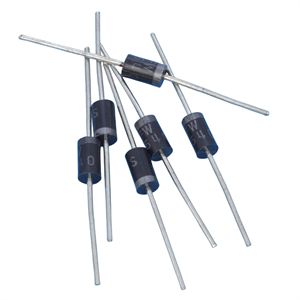Date:2024-09-20 Categories:Product knowledge Hits:866 From: Guangdong Youfeng Microelectronics Co., Ltd(YFW)
Fast recovery diode refers to a diode with a very short reverse recovery time (less than 5us). Gold doping measures are often used in the process, and PN junction structure is used in the structure, while some use improved PIN structure. Its forward voltage drop is higher than that of ordinary diodes (1-2V), and its reverse voltage withstand is mostly below 1200V. In terms of performance, it can be divided into two levels: fast recovery and express recovery, as well as three levels: ultra fast recovery. The former has a reverse recovery time of several hundred nanoseconds or longer, while the latter is below 100 nanoseconds.
Schottky diode is a diode based on the potential barrier formed by the contact between metal and semiconductor, abbreviated as Schottky Barrier diode. It has a forward voltage reduction (0.4-0.5V), a short reverse recovery time (10-40 nanoseconds), a large reverse leakage current, and a low withstand voltage, generally below 150V. It is commonly used in low-voltage applications.
These two types of diodes are commonly used in switch mode power supplies.
The difference between Schottky diodes and fast recovery diodes: the recovery time of the former is about 100 times smaller than that of the latter, while the reverse recovery time of the former is about a few nanoseconds.
The advantages of the former include low power consumption, high current, and ultra-high speed! The electrical characteristics are of course diodes.
Fast recovery diodes are manufactured using processes such as gold doping and simple diffusion, which can achieve high switching speed and high voltage resistance. Currently, fast recovery diodes are mainly used as rectifying components in inverter power supplies
Schottky diode: Low reverse withstand voltage value of 40V-50V, on state voltage drop of 0.3-0.6V, and reverse recovery time of less than 10ns. It is a diode with Schottky characteristics and a "metal semiconductor junction". Its forward starting voltage is relatively low. In addition to materials, the metal layer can also be made of materials such as gold, molybdenum, nickel, titanium, etc. Its semiconductor materials are made of silicon or gallium arsenide, mostly N-type semiconductors. This device is conducted by majority carriers, so its reverse saturation current is much larger than that of PN junctions conducted by minority carriers. Due to the minimal storage effect of minority carriers in Schottky diodes, their frequency response is only limited by the RC time constant, making them an ideal device for high-frequency and fast switching. Its operating frequency can reach 100GHz. And MIS (metal insulator semiconductor) Schottky diodes can be used to make solar cells or light-emitting diodes.
Fast recovery diode: With a forward conduction voltage drop of 0.8-1.1V and a reverse recovery time of 35-85nS, it quickly switches between conduction and cutoff, increasing the frequency of device use and improving waveform. Fast recovery diodes are manufactured using processes such as gold doping and simple diffusion, which can achieve high switching speed and high voltage resistance. Currently, fast recovery diodes are mainly used as rectifying components in inverter power supplies
Typically, fast recovery diodes ranging from 5 to 20A are packaged in TO-220FP plastic, high-power fast recovery diodes above 20A are packaged in TO-3P plastic with a metal heat sink at the top, and fast recovery diodes below 5A are packaged in plastic specifications such as DO-41, DO-15, or D0-27.

Previous: Classification, Structure, and Principle of MOSFET
Next: Classification, Structure, and Principle of Field Effect Transistors